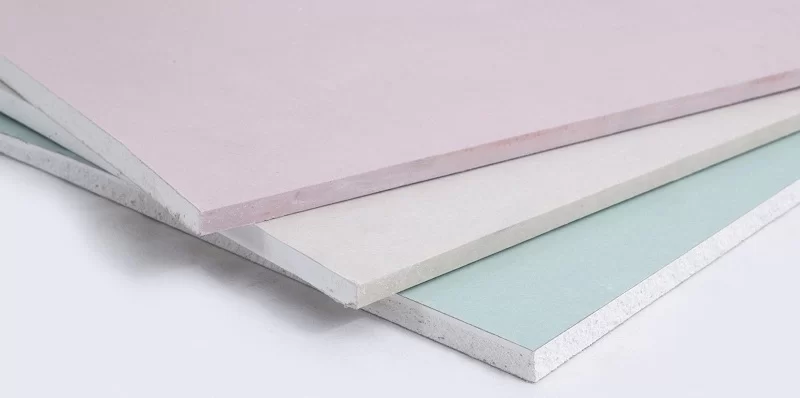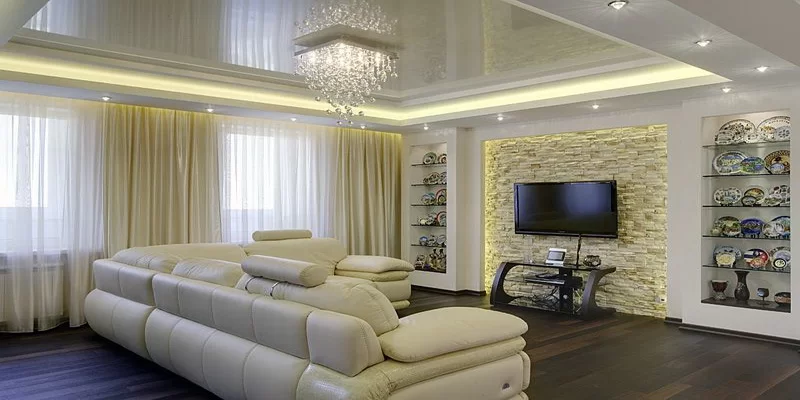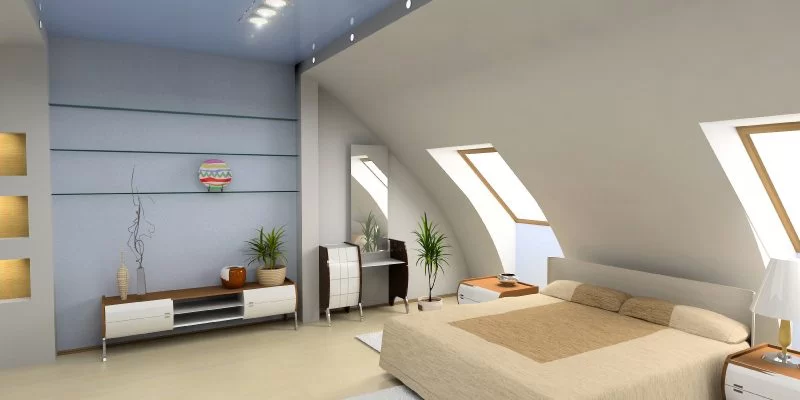Our experts in the field of construction and repair examined the properties and features of two similar materials — drywall (gypsum plasterboard) and gypsum fiber (GVL), their areas of application, made a comparative analysis of their advantages and disadvantages, which will help you make a choice in favor of one or the other.
Drywall

Gypsum board is a finished panel of a certain size, made from a thin layer of gypsum plaster, which is sandwiched between two layers of thick cardboard. Drywall has sufficient strength, while being easy to process — it is cut into smaller sheets with a construction knife, and fastening to the surface to be trimmed is carried out using self-tapping screws. The gypsum base may include special additives that give the material special properties and allow the manufacture of different types of drywall, which can be used to solve various tasks in finishing work.
Varieties of drywall and characteristics
The material is divided into 5 main types:
-
Regular or Standard. It is marked with three letters — GKL. This type can be distinguished by the gray surface of the sheet with blue markings.
-
Moisture resistant. Marking — GKLV, surface color — green with blue marking;
-
Fire resistant. Marking — GKLO, surface color — pink with red marking;
-
Fire and moisture resistant — combines the properties of resistance to fire and moisture. Surface color — green with red marking;
-
Acoustic. Marking — AKU, surface color — purple.
Geometric characteristics of drywall sheets: the usual and most common sheet size is 1200x2500 mm, although some manufacturers produce sheets of different sizes — from 1500 to 4000 mm long and 625 mm wide. The thickness of the sheet can also vary within 6–12.5 mm.
Drywall may vary in the shape of the edges. The following types of products are produced, which differ in the profile of the edges:
-
with rectangular edges — marking — PC;
-
with an edge that decreases in thickness on one side — marking — UK;
-
with an edge having a semicircular shape on one side, marking — PLC;
-
simultaneously reduced and rounded edge on one side, marking — PLUK;
-
rounded edge, marking — ЗК.
The edges are profiled to facilitate the work on sealing the joints after the installation of the sheets.
For different tasks of finishing or building structures, different sheets with different characteristics are selected.
Areas of application of drywall

Drywall is used in construction for the following purposes:
-
a conventional gypsum plasterboard sheet, having a thickness of 12.5 mm, is used instead of wet plaster for finishing main walls, as well as partitions in rooms with normal operation. After sheathing, standard finishing is performed;
-
ordinary plasterboard with a thickness of 12.5 mm is used for sheathing frame partitions, the frame of which is constructed from a wooden beam or thin-walled steel profile in rooms with normal operation;
-
ordinary plasterboard with a thickness of 8 or 9.5 mm is used instead of wet plaster as ceiling cladding in rooms with normal operation. The same type of material is used as a sheathing for suspended and false ceilings on a frame made of wooden beams or steel profiles;
-
moisture-resistant sheet of the GKLV brand is used for finishing walls and ceilings in rooms with a high humidity regime — kitchens, bathrooms, showers, bathrooms, etc. For walls — material 12.5 mm thick, for ceilings — 8 and 9.5 mm thick;
-
fire-resistant material of the GKLO brand is used for the installation of fire barriers, as well as cladding of steel and reinforced concrete structures in order to increase stability when exposed to high temperatures and open flames;
-
ordinary GKL 6.5 mm thick is used in the construction of structures of complex shape — arches, sheathing of rounded walls and round columns, multi-level suspended ceilings. Such sheets are easy to bend due to their small thickness after wetting with water, and if necessary, facing surfaces of large curvature, they are cut into segments and then bent;
-
sheet GKVLO — fire-resistant and moisture-resistant, used for finishing rooms in which the operating mode is characterized by increased fire hazard and humidity at the same time, for example, saunas or baths;
-
Acoustic sheet of the AKU brand is used in the decoration of premises with increased requirements for sound insulation — concert halls, cinemas, recording studios, etc.
Gypsum fiber sheet

Gypsum-fiber sheet is a thin building panel made using the semi-dry pressing method from a mixture of building gypsum and cellulose fibers with surface reinforcement with fiberglass mesh. GVL is much stronger than drywall, so a special tool is needed to cut it — a hacksaw, grinder, circular saw or electric jigsaw. It is attached to the surface to be trimmed not with self-tapping screws, but with special screws designed specifically for GVL. Gypsum fiber sheets are divided into several types that have different properties and are used for different purposes.
Properties and characteristics of GVL
-
gypsum-fiber sheets are divided into two types that can be used in rooms with different humidity conditions — standard, marked as GVL and moisture resistant, marked — GVLV;
-
geometric characteristics: length — 1500, 2000, 2500, 2700 and 3000 mm; width — 500, 1000 and 1200 mm; thickness — 10, 12.5, 15, 18 and 20 mm;
-
just like drywall, sheets are subdivided according to the shape of the edge — with a rectangular edge, marked — PC; with a folded edge, marked — FK;
-
all products have the same gray color and are marked with blue paint. For example, the standard marking of a GKL sheet is: GVLV-FK-2500x1200x1.5 GOST R 51829–2001, which means a moisture-resistant gypsum-fiber sheet with a folded edge, 2500x1200 mm in size, 15 mm thick.
The scope of GVL is wall cladding or the installation of frame partitions before finishing in rooms for any purpose, since gypsum fiber sheets are very durable, not afraid of moisture and are not combustible. GVL sheathe walls along the frame or fasten with mounting glue. In addition, with the help of GVL, they arrange preparations for floors, for which special plates are produced with a size of 1000x1500 mm and a thickness of up to 20 mm.
Table of advantages and disadvantages
|
|
|
|
|
|
+ environmental friendliness, since natural materials are used in the manufacture;
+ ease of processing and installation, lower labor intensity in comparison with wet plaster;
+ cleanliness of work — no dirt is formed;
+ creation of absolutely flat surfaces with the ability to create complex curvilinear ones;
+ a large selection of varieties for different areas of use;
+ much lower price in comparison with GVL;
+ low weight, which also facilitates the work with the material;
+ the ability to hide communications under the lining of walls and ceilings;
+ vapor permeability — sheathed GKL “breathe”, providing a comfortable microclimate in the premises;
+ resistance to fire.
|
- fragility, under impact, the sheets break;
- difficulty hanging equipment and interior accessories on the walls if the walls are lined with a frame, so additional racks or special structures are required;
- low moisture resistance of conventional GKL, so it can only be used in rooms with normal humidity conditions.
|
|
|
+ environmentally friendly, as it is made from natural materials;
+ not afraid of moisture;
+ high heat and sound insulation qualities;
+ belongs to the class of low combustible materials;
+ high strength, allowing hanging on walls sheathed with GVL, equipment, hanging furniture and interior accessories;
+ vapor permeability, allowing the walls to “breathe”;
+ easy to mount;
+ cleanliness of work, no dirt is formed;
+ the material is not affected by large temperature fluctuations.
|
- much more expensive than GKL;
- slabs are heavier than gypsum boards, therefore they require the installation of a more powerful frame for sheathing;
- it is not plastic, therefore it can be used for facing only flat surfaces;
- when cutting, a lot of dust is generated, so you need to work in a respirator and goggles;
- cutting requires a special tool, unlike GKL.
|
The main differences between materials

The main differences between the materials are as follows:
-
GKL is a kind of sandwich — a layer of gypsum is enclosed between two layers of cardboard, GVL has a uniform structure with reinforced surfaces with fiberglass meshes;
-
GVL is much stronger — dowels and nails can be hammered into walls sheathed with GVL, it is impossible in GKL;
-
standard GVL sheets are much more resistant to moisture than GKL;
-
GKL can be bent and cut into segments for cladding curved structures, GVL is only suitable for cladding flat surfaces;
-
GVL is much more resistant to low temperatures — it can withstand more than 15 freeze-thaw cycles, GKL only 4 cycles, after which cracks can form on it;
-
GVL has a large scope — with the help of GVL boards, preparations for floors can be arranged, unlike GKL;
-
GKL sheets are capable of crumbling on sections when cutting, GVL sheets are not;
-
GVL is much more expensive than GKL.
What is the similarity of materials
The similarity of materials is as follows:
-
both materials are made on the basis of building gypsum;
-
both materials can be used in the premises of the same purpose;
-
and GKL and GVL have a similar appearance — flat facing panels or sheets;
-
both materials belong to the same group G‑1 — low combustible materials for fire safety.
Conclusions: It is impossible to make an unambiguous conclusion that one material is better than another, each of them has its own advantages and disadvantages. The choice should be made based on the task that must be solved during the finishing work, since only GKL is suitable for some types of work, for example, for creating or cladding curved structures. For other works, only GVL can be used, as for laying bases under floors. And you should also take into account financial opportunities, because GVL is much more expensive.

Добавить комментарий
Для отправки комментария вам необходимо авторизоваться.